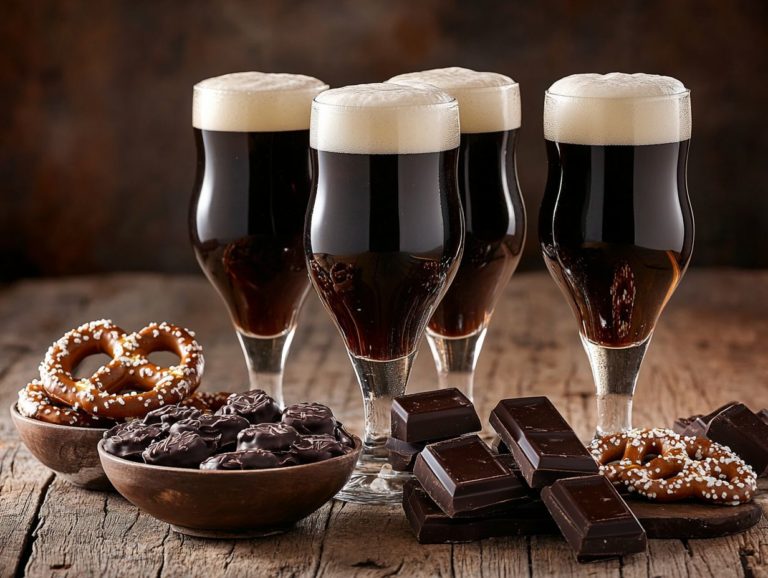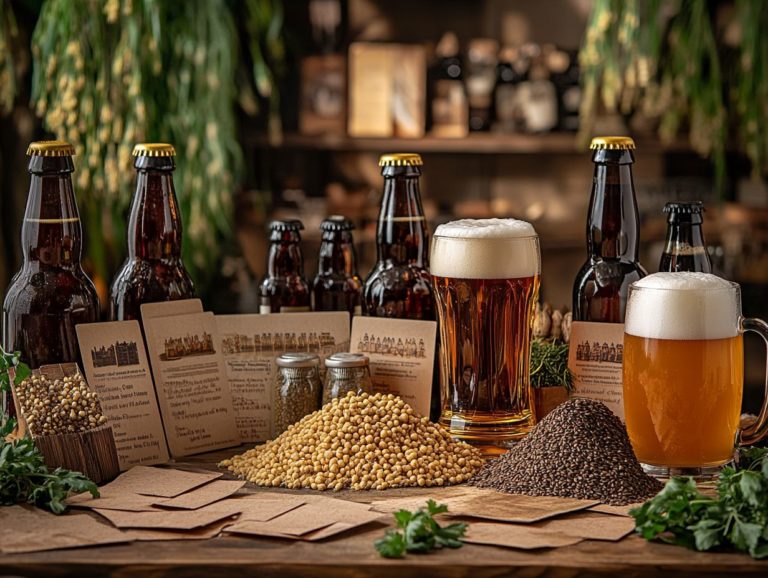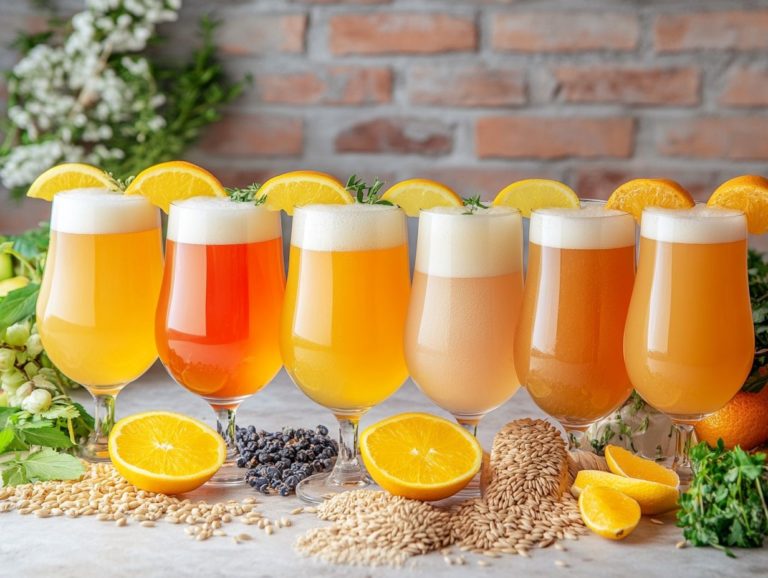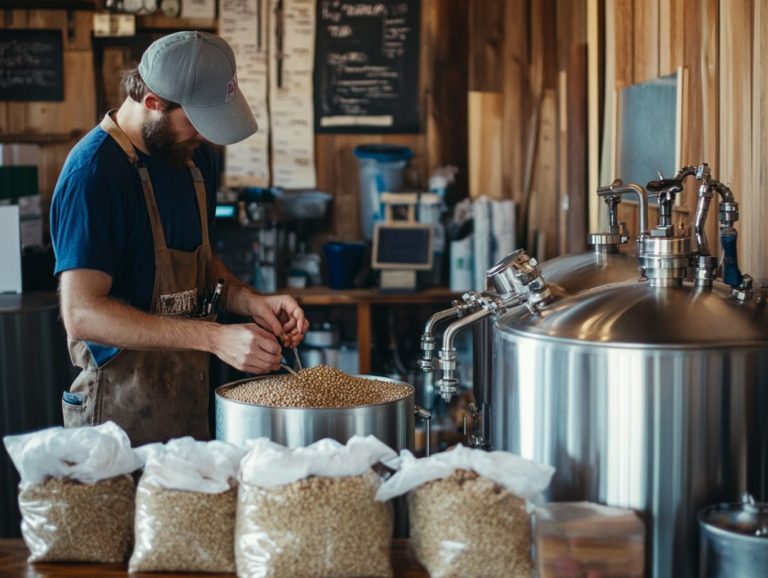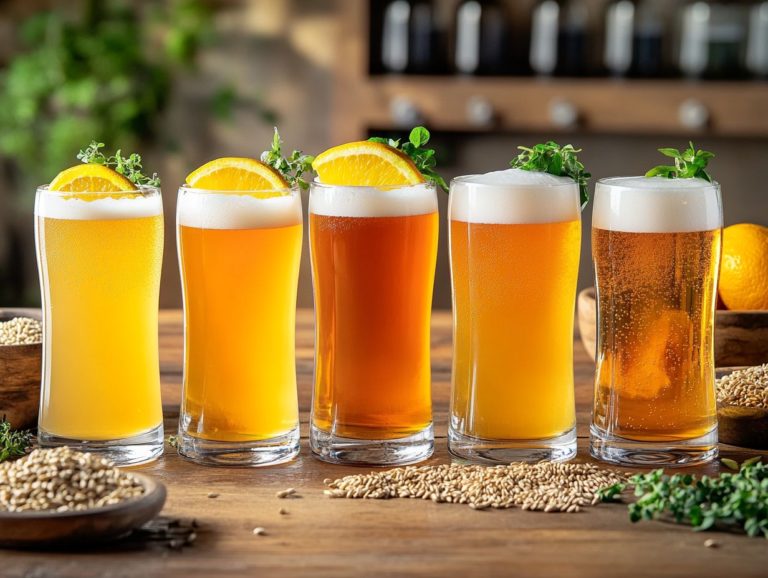10 Beer Recipes for Perfectly Balanced Brews
As a beer enthusiast eager to create your own perfect homebrew recipes, you re about to dive into an exciting world of brewing beer!
This article unveils ten diverse beer recipes, each meticulously crafted to tantalize your taste buds and showcase a myriad of unique flavors. From classic lagers to refreshing fruity sours, including light beers, you ll find something to satisfy every palate.
The article covers essential brewing ingredients, methods, customization tips, and complementary food pairings, all designed to elevate your brewing experience. No matter if you’re a beginner or a brewing pro, these recipes will ignite your passion!
Contents
- Beer Recipes
- 3. Rich and Malty Porter Recipe
- 4. Light and Refreshing Wheat Beer Recipe
- 5. Spicy Saison Recipe
- 6. Creamy Stout Recipe
- 7. Fruity and Tart Sour Beer Recipe
- 8. Hoppy and Bitter Double IPA Recipe
- 9. Belgian Tripel Recipe
- 10. Smoky and Robust Rauchbier Recipe
- What Are the Key Ingredients Needed for Brewing Beer?
- How Can One Get Started with Homebrewing?
- Frequently Asked Questions
- What are some key ingredients for creating a perfectly balanced beer?
- What type of malt should I use for a well-balanced beer?
- How can I ensure my beer has a balanced bitterness?
- Can I use different types of yeast in my beer recipes?
- What are some common mistakes to avoid when making a beer recipe?
- How can I adjust a beer recipe to create a more balanced flavor?
Key Takeaways:
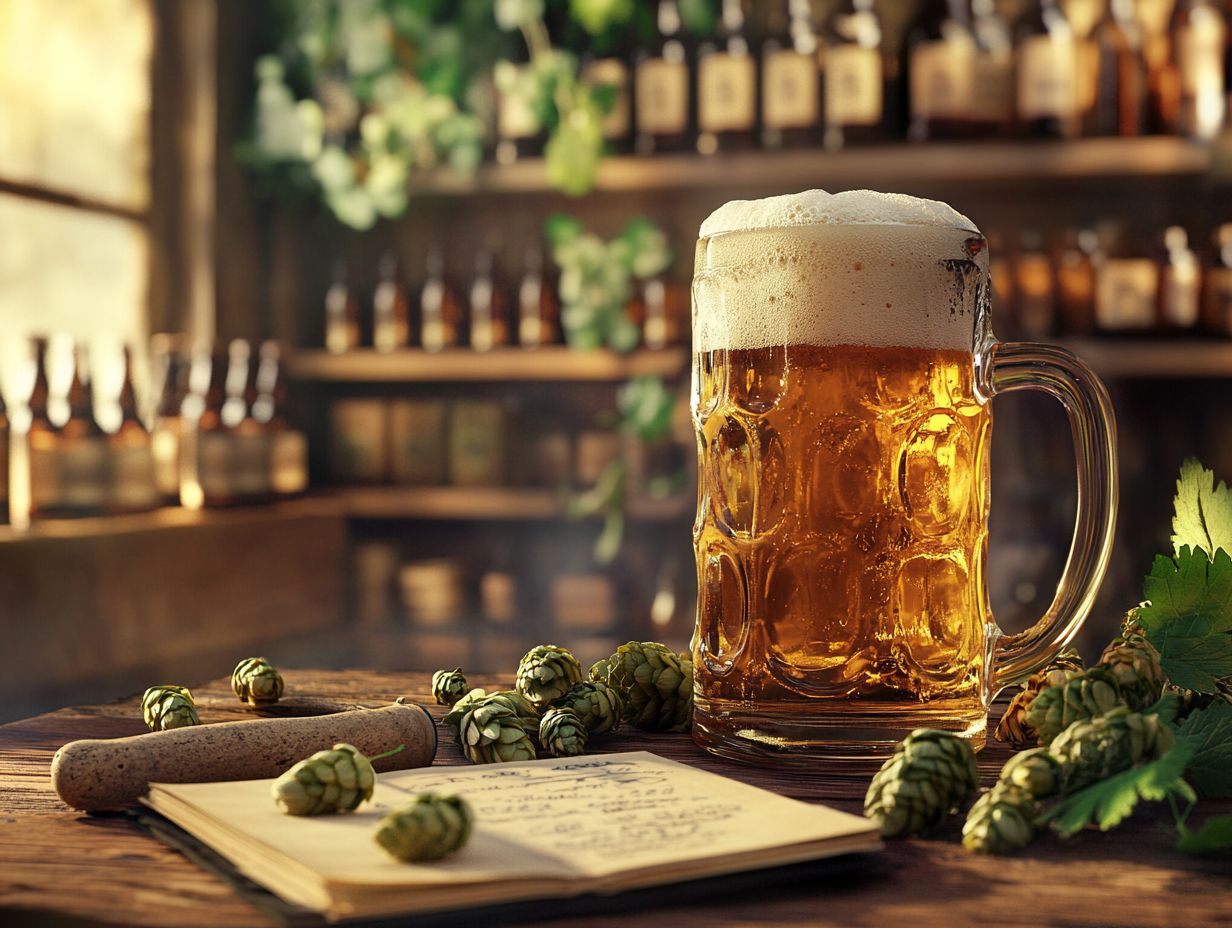
- Experiment with different styles and ingredients to create unique beer recipes.
- Consider pairing beer with complementary foods for a well-rounded experience.
- Avoid common mistakes by following proper brewing methods and using quality ingredients, as recommended by the brewing community.
1. Classic Lager Recipe
Creating a classic lager recipe requires a careful and deliberate approach to selecting the right malt and hops, balancing the fermentation process, and hitting that perfect alcohol by volume that distinguishes this beloved beer style.
The secret to crafting an exceptional lager lies in your understanding of the Beer Judge Certification Program (BJCP) style guidelines, which highlight the importance of refinement and crispness attributes that make this brew a favorite among both beer connoisseurs and homebrewers.
Whether you re just starting out or you re a seasoned brewing expert, mastering this classic style can significantly elevate your homebrew repertoire.
To achieve that quintessential taste, you ll often want to use Pilsner malt as your base, enhanced by specialty malts like Munich or Vienna for that extra depth.
In terms of hops, varieties such as Saaz and Hallertau not only impart a delicate hop aroma but also ensure a perfectly balanced bitterness.
Temperature control during fermentation is crucial aim for that sweet spot between 50 and 55 degrees Fahrenheit. This will help you achieve a clean profile while minimizing any unwanted flavors.
Don t underestimate the power of brewing software; it s a game-changer that streamlines your process, allowing for precise adjustments and helping you track various iterations in a beer recipe database. This way, refining your future brews becomes a breeze, based on the successes or insights you’ve gleaned from earlier attempts.
2. Citrusy IPA Recipe
The Citrusy IPA recipe presents a vibrant celebration of hop varieties, delivering an invigorating burst of citrus aromas and flavors that make it a favorite among craft beer enthusiasts and homebrewers alike.
As one of the quintessential American ales, it stands out in the world of brewing beer.
Citra and Mosaic hops particularly shine in this blend, known for their remarkable ability to impart an intense grapefruit and tropical fruit character that truly captivates the senses.
To elevate these flavors even further, craft brewers often utilize dry hopping during fermentation, allowing essential oils to infuse the beer without overpowering it with bitterness.
Achieving the perfect harmony between the fresh citrus aroma and the lingering hop bitterness is paramount.
Techniques such as whirlpool additions or hop bursting can beautifully highlight the fruity notes while ensuring the final product remains delightfully approachable.
By understanding these elements and their interactions, you can transform an IPA from merely good to exceptional, solidifying its status as a cherished choice in the world of craft beer.
Beer Recipes
3. Rich and Malty Porter Recipe
Crafting a rich and malty porter recipe demands a nuanced understanding of various malt extracts and the fermentation process to capture the deep, complex flavors that define this cherished brew.
To create a well-balanced porter, you ll want to incorporate specialty malts like Munich. This malt brings a delightful, bready essence to the mix.
Meanwhile, roasted barley introduces a robust, coffee-like character, deepening the color and enriching the overall flavor profile. These brewing techniques are essential for achieving the desired richness.
Employing a special mashing technique can elevate the mouthfeel, resulting in a luxurious creaminess that envelops your palate. This is a testament to the depth of brewing techniques applied.
To achieve your desired alcohol by volume, monitor fermentation temperatures and select the right yeast strains carefully. This ensures a smooth and satisfying finish expected from a quality porter. The right yeast strains and malt extracts are crucial in this process.
4. Light and Refreshing Wheat Beer Recipe
Imagine crafting a light and refreshing wheat beer recipe that s just perfect for those sweltering summer days! By combining the distinct characteristics of wheat with careful fermentation, you ll produce a crisp, thirst-quenching beverage that s sure to delight.
The foundation of this delightful brew typically features a harmonious blend of malted wheat and barley. This combination not only lightens the beer but also enriches its flavor profile with delicate fruity notes and a smooth mouthfeel.
If you decide to add other grains, like oats or rye, you can introduce an intriguing complexity while still preserving that refreshing quality. These grains are key ingredients in many beer brewing recipes.
The fermentation process is where the magic truly happens. Selecting specific yeast strains, such as German Hefeweizen or Belgian Wit, is essential for achieving the desired characteristics.
These yeasts impart vital aromas and flavors, like hints of banana and clove, elevating the sensory experience and ensuring your beer remains notably crisp and invigorating. These choices are vital in the fermentation process, critical to making the most of the warmer seasons.
5. Spicy Saison Recipe
Creating a spicy saison recipe is an art that involves selecting specific yeast strains and spices that not only elevate its flavor but also showcase the unique fermentation process inherent to this Belgian Saison style.
At the heart of this process are the Belgian farmhouse yeast strains, especially Brettanomyces and Saccharomyces. These yeasts bring forth complex notes of clove, pepper, and citrus that dance harmoniously on the palate.
They flourish at higher fermentation temperatures, typically between 75 F and 85 F, which encourages the development of that distinctive spicy character you crave. The fermentation process in this style, often highlighted in the BJCP guidelines, is truly unique.
Complementing these yeasts, you’ll want to incorporate adjuncts, which are additional ingredients used in brewing, like coriander, grains of paradise, and a hint of citrus zest. These ingredients work together to create an intriguing balance and depth that captivates the senses.
It’s vital to manage your fermentation conditions meticulously. Any fluctuations can lead to off-flavors that tarnish your masterpiece, while a steady approach will allow the full expression of those aromatic qualities.
The result? A saison that truly captures the essence of its origins, inviting you to savor every delightful sip! Exploring different yeast strains can lead to exciting new variations.
Ready to try brewing these amazing beers? We d love to hear about your experiences in the comments!
6. Creamy Stout Recipe
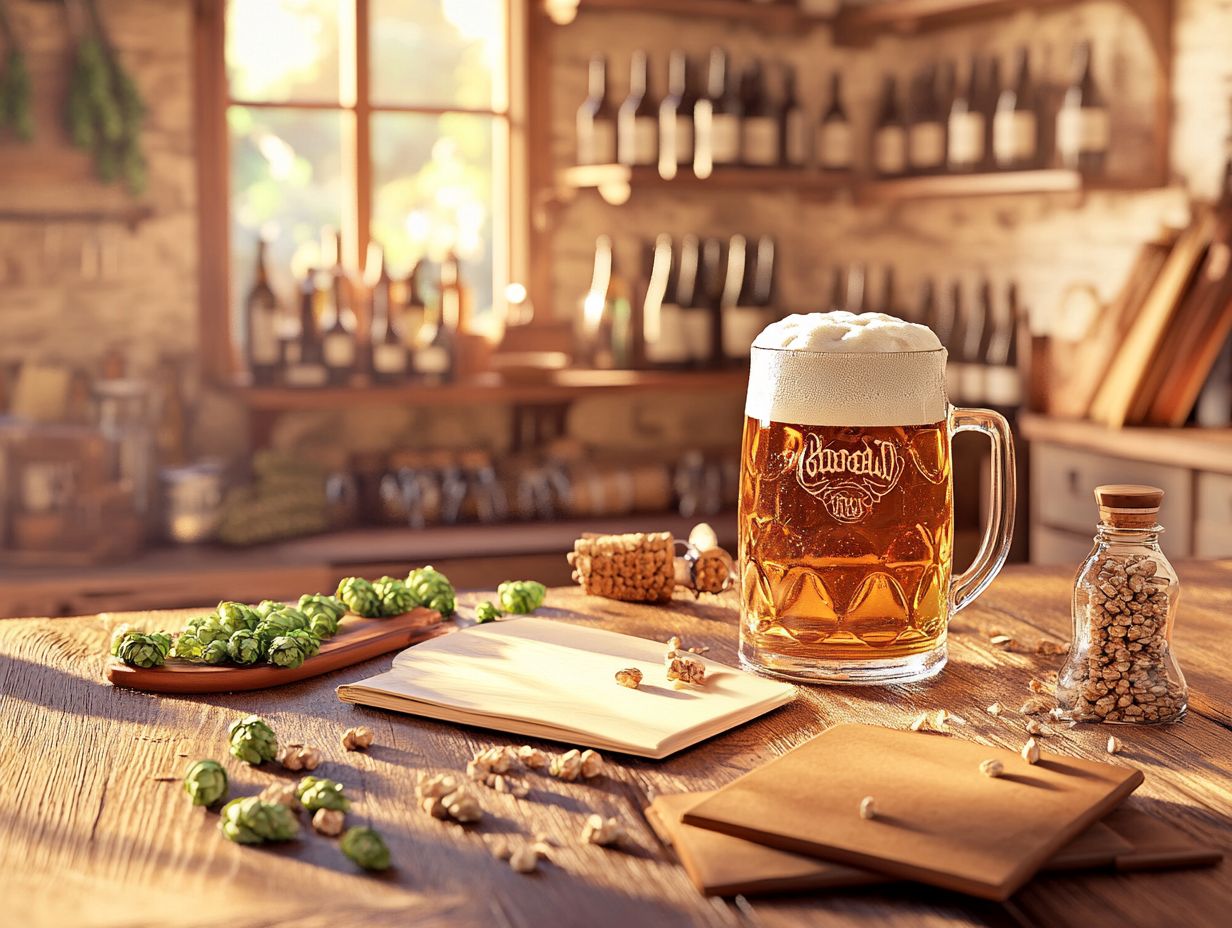
Crafting a creamy stout recipe invites you to delve into a delightful world of rich malt flavors and a luxuriously smooth mouthfeel, merging various brewing techniques to create a complex and satisfying experience. Whether you prefer a traditional stout or an American IPA, the right brewing techniques make all the difference.
To achieve this masterpiece, you ll want to incorporate a selection of malts, such as oatmeal, which enhances that coveted creamy texture, or roasted malts that deliver deep, chocolatey undertones. These ingredients are not just about flavor; they play a pivotal role in crafting a luscious body that envelops your palate in richness.
The fermentation process is where the magic truly happens, significantly influencing the final brew. It affects not only the beer’s alcohol by volume but also its overall complexity. As you strive to perfect your stout, consider experimenting with fermentation temperature and yeast strains to strike that ideal balance between sweetness and bitterness, all while ensuring a full-bodied finish that leaves a lasting impression. Utilizing the best brewing software can help you track these variables accurately.
7. Fruity and Tart Sour Beer Recipe
Crafting a fruity and tart sour beer requires a distinctive brewing approach that prioritizes wild yeast and bacteria during fermentation, resulting in that signature combination of tartness and fruitiness. Whether you are brewing an experimental sour or a traditional Doppelbock, the right ingredients and techniques are essential.
You might find that this brewing technique often embraces methods like kettle souring, which allows for quick fermentation directly in the brew kettle. This process enables you to achieve a more immediate sour flavor without the lengthy aging associated with barrel-aging. In the brewing community, kettle souring is a popular method for achieving quick results.
On the other hand, barrel-aging introduces a symphony of complex flavors, as the wood interacts with the beer, layering in notes of vanilla, oak, and subtle hints of whiskey or wine, depending on the barrels you choose. This method is often highlighted at brewing festivals for its intricate results.
In terms of selecting fruits think raspberries, peaches, or cherries these choices are paramount in enhancing the sour character of your final product. Not only do these fruits contribute their natural sugars to aid in fermentation, but they also infuse each batch with their unique tartness and aroma, ensuring that every sip is distinctly memorable. The right ingredients can turn a good beer into an exceptional craft beer.
8. Hoppy and Bitter Double IPA Recipe
Crafting a hoppy and bitter double IPA is an exhilarating challenge that allows you to explore a diverse array of hop varieties, each contributing to the brew’s robust bitterness and captivating aroma. Whether you are brewing an American IPA or a more unique creation, hop varieties play a critical role.
Consider popular options like Citra and Mosaic, celebrated for their impressive alpha acid content, typically ranging from 12% to 14%. These hops deliver vibrant citrus and tropical fruit flavors that can make your double IPA truly stand out. If you follow the BJCP style guidelines, you might also want to experiment with varieties such as Simcoe or Amarillo, which introduce delightful earthy and floral notes, further enhancing the complexity of your creation. This approach aligns with popular American IPA profiles.
To achieve optimal hop utilization, you may find it beneficial to employ techniques like dry hopping. This method infuses fresh hop aromas during the final stages of fermentation, adding depth to your brew. Additionally, timing is key during the boil; early hop additions intensify bitterness, while later additions preserve those delicate aromatic qualities. These are crucial brewing techniques to master. Mastering these techniques not only brings out the best in your hops but also elevates the overall drinking experience for you and your guests.
9. Belgian Tripel Recipe
Crafting a Belgian Tripel recipe requires your attention to specific yeast strains and fermentation techniques, which are paramount for achieving the complex flavors and high alcohol by volume that define this iconic beer style. Following BJCP guidelines can help ensure your Tripel meets traditional standards.
The choice of yeast is essential; it plays a pivotal role in developing the signature fruity and spicy notes that characterize a Tripel. During fermentation, these yeast strains will convert sugars into alcohol and carbon dioxide while simultaneously producing esters (fruity compounds) and phenols (aromatic compounds), which enrich the beer’s aroma and taste. Properly chosen yeast strains are a cornerstone of successful homebrew.
Incorporating sugar additions can elevate the alcohol by volume without sacrificing flavor, allowing the profile to remain beautifully balanced. Keep a close eye on fermentation temperatures to unlock the best flavors! These can significantly influence the development of those desired flavors, resulting in a harmonious blend that truly captivates the palate. Leveraging brewing apps can help you keep track of these variables effectively.
10. Smoky and Robust Rauchbier Recipe
Developing a smoky and robust Rauchbier recipe requires you to select your malts thoughtfully and employ careful brewing techniques to create the signature smoked flavor that defines this unique beer style.
When considering the types of smoked malts, you might find yourself gravitating toward beechwood or cherrywood, as both offer distinct flavor profiles that can elevate your beer’s complexity. Beechwood smoked malt typically imparts a gentle, bacony essence, while cherrywood brings a sweeter, more fruity smokiness to the table. These choices are often highlighted in beer style guidelines for classic smoked beers.
As you navigate the fermentation process, managing temperatures becomes crucial; higher temperatures might enhance fruity esters and phenolic compounds, which can either complement or clash with the smokiness you’re aiming for. Balancing this signature characteristic with other flavors like caramel sweetness or a hint of hops ensures that your final product isn’t merely one-dimensional. This careful balance is often achieved by consulting with the brewing community for advice and tips, including exploring 10 beer recipes that elevate your brewing game.
Instead, it will offer a harmonious blend that tantalizes the palate and leaves drinkers eagerly anticipating another sip.
What Are the Key Ingredients Needed for Brewing Beer?
Brewing beer involves a selection of key ingredients that are vital for crafting a diverse array of styles and flavors: malt, hops, yeast, and water. These brewing ingredients form the very foundation of the brewing process.
The choice of malt you make can dramatically impact the beer’s color, sweetness, and body. For instance, pale malts deliver a subtle, light flavor, ideal for light beers, while darker malts introduce rich notes of chocolate or caramel that can elevate your brew.
Hops are where things get interesting, bringing bitterness and aroma into the mix. Different hop varieties can transform your beer’s character; Cascade hops lend a delightful citrusy quality, while Saaz hops offer an earthy profile that adds depth and complexity.
Don’t underestimate the role of yeast strains in fermentation. The right strain can produce a spectrum of distinctive flavors, ranging from fruity esters to spicy phenols, each adding its unique touch to your beer. This aspect is crucial for crafting unique beer brewing experiences.
Lastly, water chemistry mineral content and pH levels plays a crucial role in the extraction of flavors from the grains and the overall mouthfeel of your brew. Every ingredient interacts intricately, working together to create a well-balanced final product that reflects your brewing prowess. This is especially important when brewing traditional styles like Munich Helles or Belgian Saison.
What Are the Different Methods for Brewing Beer?
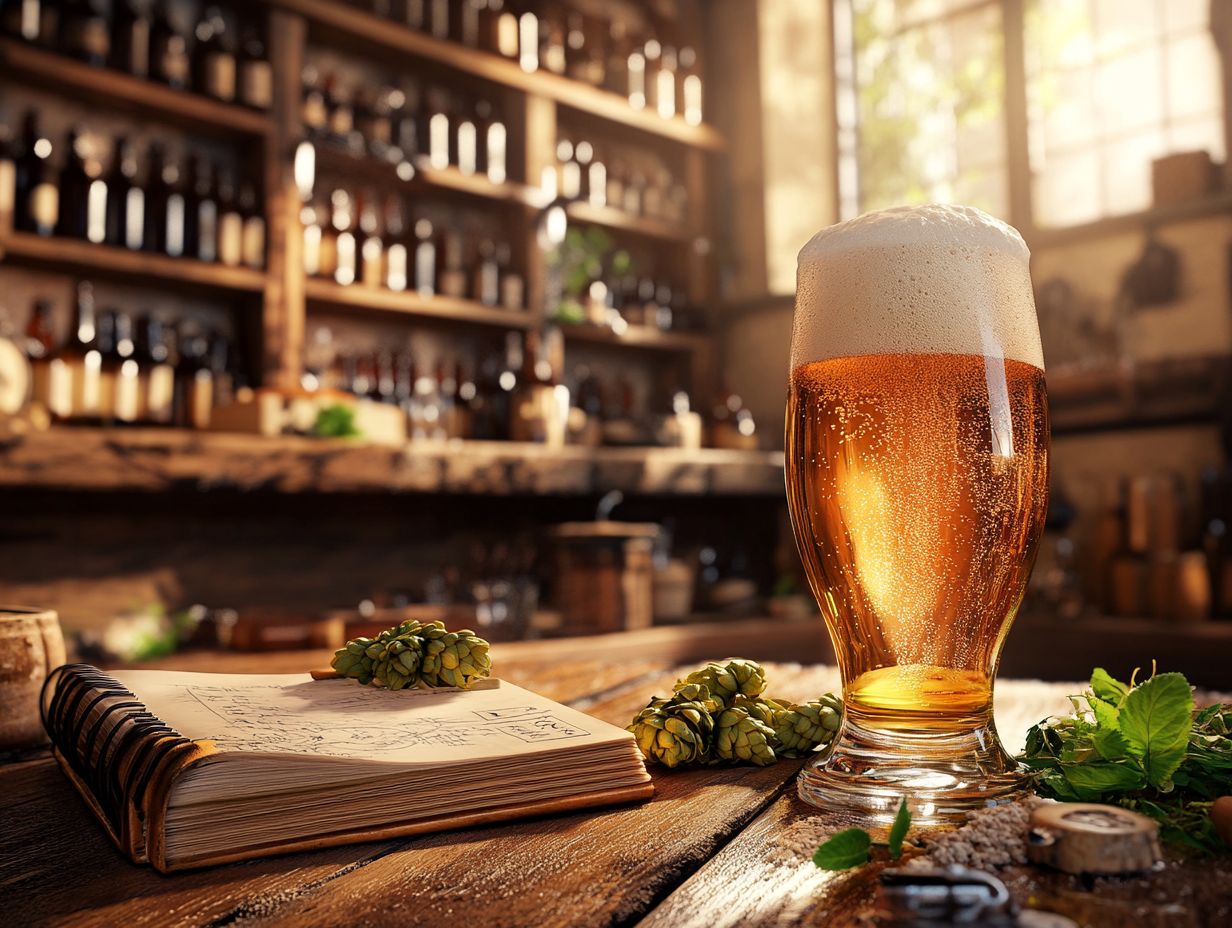
There are numerous methods for brewing beer, each influencing the final flavor, aroma, and character of your beloved beverage, ranging from time-honored methods to cutting-edge innovations in fermentation and ingredient selection. Both traditional and modern approaches are celebrated in the brewing community.
As a homebrewer, you ll often find yourself deciding between all-grain brewing and extract brewing. All-grain brewing, which involves using whole grains and a mash process, gives you greater control over the flavor profile and opens the door to experimenting with different grain types. Extract brewing simplifies your brewing journey by utilizing pre-processed malt extract, making it an inviting option for beginners.
Tools like recipe software can assist you in managing these different methods. Don’t underestimate the importance of fermentation techniques in your brewing adventure. By managing fermentation temperature and choosing the right types of yeast, you can greatly affect how clear, flavorful, and aromatic your beer is. For inspiration, check out these 10 must-try beer recipes for home brewing enthusiasts. By mastering these elements, you can fine-tune your recipes, allowing for a truly personalized brewing experience that reflects your unique taste.
How Can One Customize These Recipes to Their Taste?
Customizing homebrew recipes to suit your personal taste is one of the most exhilarating facets of brewing, enabling you to experiment with a variety of ingredients and techniques to craft your unique beer.
By carefully selecting specific hop varieties, malt profiles, and types of yeast, you can profoundly influence the flavor, aroma, and overall character of your brew. For instance, choosing fruity or floral hops can elevate the beer’s bouquet, while a rich, caramel malt can introduce depth and sweetness. This approach works well with a variety of beer styles, from a crisp Pilsner to a robust Doppelbock. If you’re looking to explore more, check out these 10 unique beer recipes for craft beer lovers.
The selection of yeast is crucial, as it plays a significant role not only in the fermentation process but also in shaping the beer’s mouthfeel and esters. To effectively manage these adjustments and their outcomes, maintaining a comprehensive beer recipe database is essential. Documenting each batch with detailed notes on ingredient ratios, brewing conditions, and tasting results allows you to track your progress and refine your craft over time. For inspiration, consider checking out 10 classic beer recipes that every brewer should know, ultimately leading to a brew that is distinctly your own. Crafting your brew with such detail will impress your friends and elevate your status as a beer enthusiast!
What Are the Best Food Pairings for These Beer Recipes?
Pairing food with beer not only enhances your dining experience, but it also opens the door to a world of flavor exploration. Understanding which dishes harmonize with specific beer styles can significantly elevate your enjoyment of craft beer. Events like a beer festival can offer inspiration for such pairings.
By looking into the intricate interplay of flavors between various beer styles and culinary creations, you can uncover delightful combinations that tantalize your palate. For example, imagine a rich stout beautifully complemented by the bold flavors of dark chocolate desserts, where the bitterness of the beer melds seamlessly with the sweetness of the chocolate.
Consider a crisp, hoppy IPA paired with spicy dishes like buffalo wings; the beer’s bitterness works wonders to balance the heat, creating a sensational contrast. Meanwhile, a refreshing lager can enhance the freshness of seafood, such as grilled shrimp tacos, providing a clean backdrop that showcases both the beer and the dish. A traditional Weizen pairs wonderfully with sausages and lighter fare.
These thoughtfully crafted pairings not only elevate the flavors on your plate but also contribute to a truly memorable dining experience.
Ready to brew? Dive into the world of beer crafting and create a recipe that s uniquely yours!
What Are Some Common Mistakes to Avoid When Brewing Beer?
As a new homebrewer, you ll want to avoid common pitfalls that can compromise your beer quality, such as poor sanitation and incorrect fermentation temperatures. These missteps can lead to results that fall short of your expectations. Common homebrewing tips can help you avoid these issues.
Often, these issues arise from a limited understanding of the brewing process and the significance of each step involved. For instance, neglecting to sanitize your equipment introduces unwanted bacteria. This can negatively affect the flavor and aroma of your beer. Similarly, inaccurate measurements of ingredients like hops and malt can create an imbalance between bitterness and sweetness. If you don’t keep an eye on fermentation temperatures, you might end up with off-flavors and those pesky unwanted esters. To enhance your brewing skills, check out these 10 seasonal beer recipes for every occasion.
However, you can elevate your brewing game by implementing precise measuring techniques, utilizing a well-maintained fermentation chamber, and regularly checking the specific gravity (a measure of sugar content in your brew). By doing so, you can troubleshoot effectively and refine your skills, ultimately ensuring a delicious final product that you can be proud of. Engaging with the brewing community offers valuable insights and support.
How Can One Get Started with Homebrewing?
Getting started with homebrewing is an exciting venture that combines essential equipment, foundational knowledge of brewing techniques, and access to reliable beer recipes crafted for beginners.
To embark on this rewarding journey, you’ll want to invest in key items that will set you up for success. Consider adding these essentials to your toolkit:
- a fermentation vessel
- an airlock
- a thermometer
- a hydrometer
- bottling supplies
- malt extract
Opt for simple homebrew recipes, such as a basic pale ale or a classic wheat beer, as they are perfect for familiarizing yourself with the brewing process. Grasping brewing techniques, particularly sanitation and temperature control, is essential, as these factors significantly influence the quality of your final product. Consider exploring different beer styles like American IPA or Belgian Saison to expand your skills.
As you brew, it s wise to take meticulous notes during each session and embrace the learning curve; after all, every batch is a chance to refine your craft and elevate your brewing skills. Engaging with the brewing community and using brewing software can also greatly enhance your homebrewing journey.
Frequently Asked Questions
What are some key ingredients for creating a perfectly balanced beer?
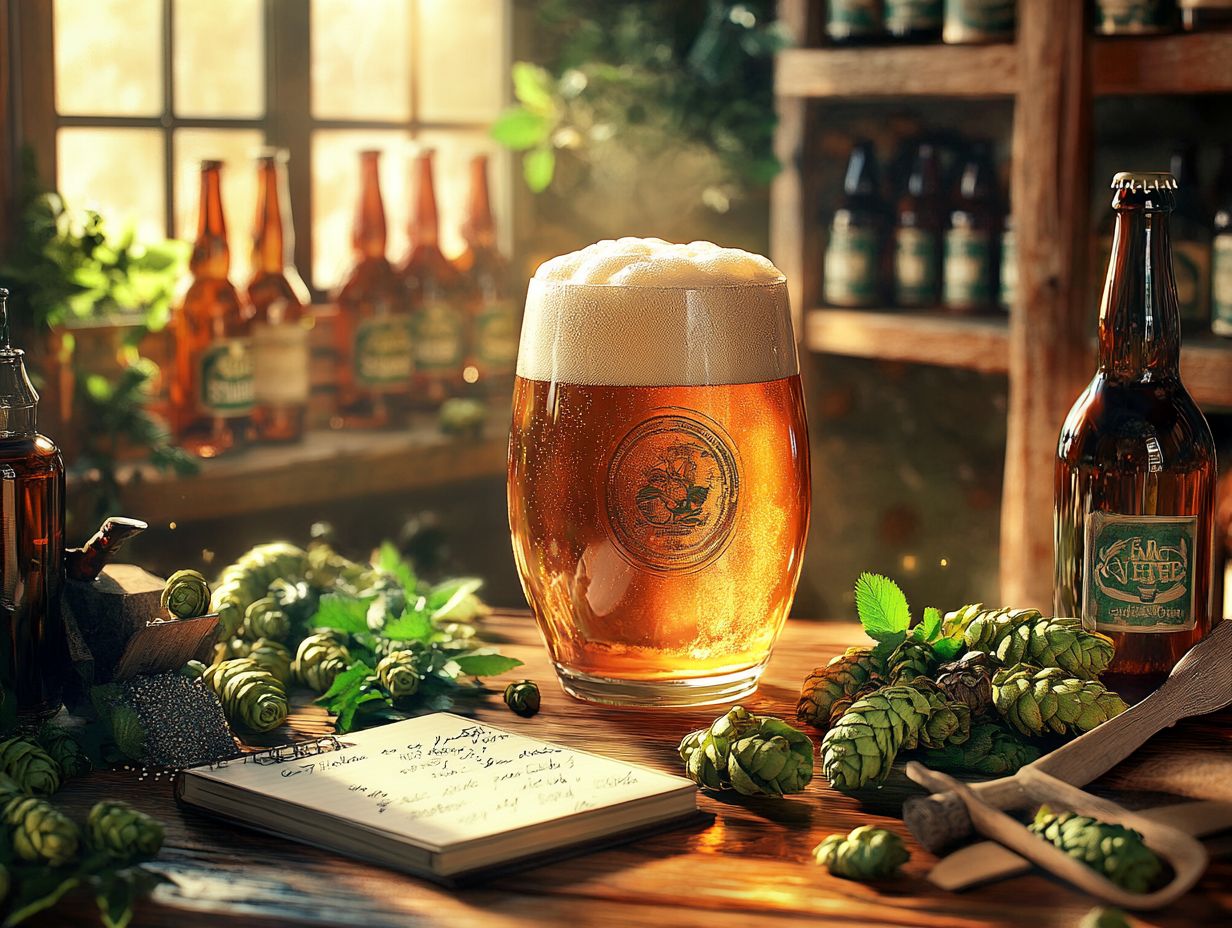
Key ingredients include malt, hops, yeast, and water. It’s crucial to follow BJCP style guidelines to achieve the desired balance.
What type of malt should I use for a well-balanced beer?
Using a combination of base malt and specialty malt, such as Munich or Weizen, is recommended for a balanced beer. Specialty malts add unique flavors and colors.
How can I ensure my beer has a balanced bitterness?
The key to balancing bitterness is to use the right amount of hops. Be sure to calculate the bitterness units (IBUs) and use a balanced ratio of hops in your recipe. Consider using a recipe software to manage these calculations easily.
Can I use different types of yeast in my beer recipes?
Absolutely! Different yeast strains can create unique flavors and aromas in your beer. Choose a yeast that balances well with the other ingredients to enhance the flavor.
What are some common mistakes to avoid when making a beer recipe?
Common mistakes include:
- Using too much specialty malt
- Not controlling fermentation temperature
- Not properly measuring ingredients
These can all result in an unbalanced beer. Follow proper brewing techniques to sidestep these mistakes.
How can I adjust a beer recipe to create a more balanced flavor?
Experimenting with ingredients is the thrilling part of brewing! If your beer is too bitter, add more malt to balance it. If it’s too sweet, add more hops. Adjusting ingredients is key to achieving a perfectly balanced brew. Using a beer recipe database can help you learn from other brewers’ successful adjustments.

